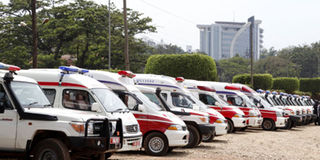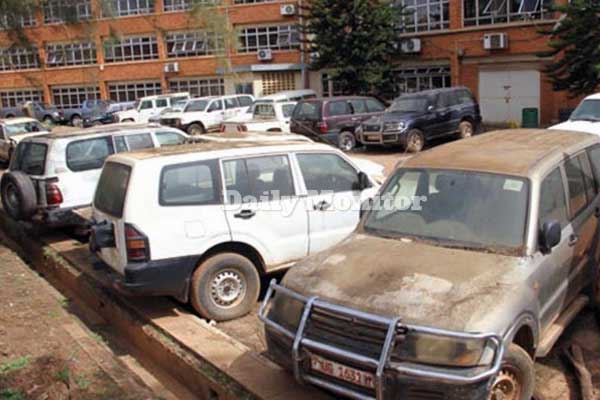Prime
Uganda requires 460 ambulances, says ministry

A number of ambulances parked at the National Ambulance Emergency Coordination centre at Mulago hospital which had been created to respond to emergencies when the Pope visited Uganda in 2015. PHOTO BY STEPHEN OTAGE.
What you need to know:
- Government hopes to have a strong fleet of ambulances that can respond to emergencies in real time.
The Ministry of Health has said the country has less than half of the 460 ambulances required to curb preventable deaths arising from gaps in emergency services.
Dr John Baptist Wanyiaye, the commissioner in-charge of emergency services at the Health ministry, yesterday said they have 183 ambulances.
“The ones at the national level are 128, and there are 50 ambulances at the district level. That gives us 178 fully functional type B ambulances,” he said.
The type B ambulances are equipped with diagnostic equipment, cardio-pulmonary support equipment, monitors, and suction machine, among others.
“Across the country, we need 460 ambulances. We are going to phase out type A ambulances. The plan is that every 100,000 people should have one type B ambulance and each two million people should have 1 type C. We so far have five [type C ambulances] but we are procuring another five and by end of the year. Our plan is to have 30.”
Type A ambulance is basically a patient carrier with no medical equipment while a Type C ambulance is an intensive care unit ambulance which has advanced life support equipment.
ALSO READ: About the state of our healthcare system
Dr Wanyiaye made the revelations at the Ministry of Health headquarters in Kampala after Health minister Jane Ruth Aceng flagged off six ambulances to Omoro, Ntungamo, Wakiso, Kanungu, Manafwa and Lira City.
Dr Aceng said: “The ambulances will not only provide maternal and reproductive health services but address emergency medical services as well. Of recent, we have had a lot of accidents on the highways, very fatal accidents, extremely painful.”
She added: “Our hope is that we have a strong fleet that can respond in real time to these emergencies and get the people safely to where they can get the proper care.”
Report
A report presented last month to Parliament by Dr Charles Ayume, the chairperson of the parliamentary Health Committee, indicates that there is a funding gap of Shs20.8b for a phased establishment of the National Ambulance Service System.
“Whereas type A is being phased out, there is a funding gap of Shs767.3 billion required to purchase 219 type B at a total of Shs59.1 billion, 15 type C ambulance at Shs5.6 billion. One boat ambulance at ShsO.5b, 50 paramedic bikes at Shs0.75b, operationalisation of eight regional call and dispatch centres at Shs6.7b and staffing at Shs12.67 billion annually,” the report reads.




